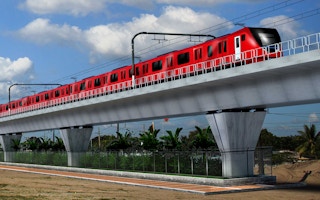It is 6pm in the Philippines and while the majority of office workers are battling their way home through rush hour traffic, Nady Tanguan is heading to work.
Tanguan is a call center agent in Metro Manila, 37 kilometres south of the suburbs where she lives in Bulacan.
Her night shift does not start until 8pm, but she has to head out early to avoid her quick ride turning into a two-hour crawl.
Tanguan considers herself lucky: she has neighbours with regular office hours who wake up at the crack of dawn to beat the rush-hour gridlock going to the city that can last up to four hours daily.
“I get an average of four hours of sleep a day because of my job, but at least I get to avoid the traffic that regular workers face during the day,” said Tanguan, 38. “What can I do? I need to earn a living for my family.”
When she gets into the city centre, the quickest way to her office is a ride on an ageing jeepney, where she suffocates in its exhaust fumes.
Tanguan is just one of the millions of urban Filipinos who shuttle back and forth between the northern provinces and the Philippine capital.
“
Lower income groups in particular will benefit from the time savings and affordability of [the railway] transport services with fares targeted at the same level as for buses in the same route.
Markus Roesner, principal transport specialist, Southeast Asia Department, ADB
Their commute could become a lot better in 2022, when a long-awaited rail line linking provinces in the outskirts of Metro Manila to the city centre is expected to begin operations.
The 53.1km Malolos–Clark Railway Project will link Malolos, a suburb of Metro Manila, to the Clark economic zone, a thriving hub of urban development in Central Luzon.
The project is part of the larger North–South Commuter Railway, a suburban railway network spanning 163km from New Clark City in Tarlac province in the north to Calamba in Laguna province in the south of Manila.
The Malolos-Clark Railway will link to the Blumentritt Station in Manila, where an elevated interchange station will connect it with other railways in the city centre.
The new rail line could ferry about 342,000 passengers a day by 2025, reducing congestion on parallel roads by 10 per cent, estimated the Asian Development Bank (ADB), which is loaning US$2.75 billion to the Philippines—the multi-lateral bank’s single largest infrastructure project financing to date.
Metro Manila has been identified as the megacity with the third worst traffic conditions in Southeast Asia, contributing to economic losses of at least US$53.6 million chalked up by the Philippines each day due to road congestion.
The reduction in greenhouse gas emissions from the Malolos-Clark Railway Project is expected to be equivalent to 60,000 tonnes of carbon-dioxide per year, as commuters shift from cars, trucks and buses to rail-based public transport. Pollution has long been a public health risk in the archipelago, which has the third-highest number of deaths in the Asia Pacific due to air pollution. Some 98 per cent of passenger transport and 55 per cent of freight transport are by road.
The rail line will be elevated, reducing the risk of flooding during rains and typhoons. The project will also use pre-fabricated viaduct segments, which limit the need for land acquisition during construction and reduce the impact on communities living along the route.
The Malolos-Clark Railway will have seven stations: Blumentritt, Calumpit, Apalit, San Fernando, Angeles, Clark, and Clark International Airport.
With trains running at up to 160km per hour, travel time between Metro Manila and Clark International Airport in Pampanga is expected to be slashed to one hour, compared to the current three-hour ride by bus.
“Lower income groups in particular will benefit from the time savings and affordability of [the railway] transport services with fares targeted at the same level as for buses in the same route,” Markus Roesner, principal transport specialist of ADB’s Southeast Asia Department, told Eco-Business. “This will help non-Manila residents gain access to employment opportunities, education and social services.”
The project will also help to decongest Metro Manila by redirecting economic growth from Manila to Central Luzon, he added.
It is part of rising investment under President Rodrigo Duterte’s infrastructure programme called Build, Build, Build, which aims to increase public spending on infrastructure from 4.7 per cent this year to 7 per cent of gross domestic product by 2022.
On July 11, the ADB awarded an initial loan of US$1.3 billion to the Philippines for the project.
The loan will finance civil works like bridges, stations and viaducts for the elevated railway alignment as well as the tunnel going to the underground station for Clark International Airport.
The Japan International Cooperation Agency’s co-financing of US$2 billion will be used to buy trains and for electrical and mechanical systems.
Commuters like Tanguan are looking forward to a quick seamless commute.
“I hope our situation improves. As it is, I’m more stressed with traffic than my work,” she said.

















